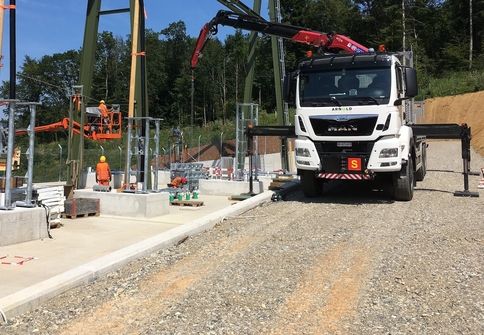Provider
Location
According to Swissgrid, the current 220 kV transmission line between Beznau and Metteln causes bottlenecks in the Swiss transmission system. To increase capacity, this double-capacity line will be converted to 380 kV on one side. The second line will continue to be operated at 220 kV for another 40 years.
Because of objections to the new line route in the Bözberg/Riniken region over the past two decades, the Swiss Federal Supreme Court ruled in 2011 that around a kilometre of the new high voltage line must be placed underground. As a result, Switzerland now has its first high voltage line with a n underground section.
Our tasks
- Engineering for visualisation of the transitional structures and cable laying in the cable vault and for converter and cable mounting
- Delivery of the site installation as well as delivery and assembly of the conduit support system for the SBB crossing
- Laying of the high voltage cables, fibre optic cables and earth cables
Project description
As part of the underground cabling for this section of the line, Swissgrid commissioned two transitional structures, a northern structure in the municipality of Riniken and a southern structure in the municipality of Villnachern, as well as a conduit block with intermediate shafts. The two buried transitional structures form the interface between the transmission lines and cables. The work also involved running the cables below the SBB’s Bözberg line, which was done with two separate cable ducts. The two 1,450–metre cable systems are double strands, each with a cross-section of 2,500 mm2 of aluminium per strand in each stage. The double strands, which have cable terminations on both sides, are monitored in the transitional structures using current converters and run outdoors via an omega strap made of 600 mm2 of aluminium per strand.
Engineering and coordination
All of the parties involved in the project were invited to an initial coordination meeting in late 2017. Together they calculated the dimensions of the transitional structures for the corresponding cable systems. The meetings were conducted by Axpo Power AG on behalf of Swissgrid. There were constant project changes during the construction of the tube block and the transitional structures, and these changes had to be reviewed by engineering services. During the engineering of the visualisations and all of the support materials we were assisted, above all, by the engineering department of our parent company, BKW.
Transitional structures and two cable ducts
The first stage involved the construction of the two SBB crossings. For the two cable ducts, Arnold installed prefabricated support material supplied by Halfen Swiss. At the same time, IBB Brugg welded together cable conduits with an outer diameter of 250 mm and prepared for installation. Working with the company Erne, they then installed the welded conduits and fastened them in the two cable ducts using omega brackets. The two cable ends were connected to the conduit block by the company Meier.
After the two transitional structures and the conduit block were constructed and approved by Swissgrid, work on the support assembly in the two cable vaults commenced. Parallel to the assembly of the two structures, which were identical in terms of construction, preparations were made for installation of the cables. Because the 12 large and heavy bobbins could not be transported to the northern transitional structure, 70-metre conduits and temporary concrete bases to mount them on had to be installed. It took a week to complete the work to position the cables, which was overseen by a supervisor from Brugg Kabel AG.
Cable installation
The cable bobbins, which are 3.8 metres wide and 4.6 metres tall, were delivered by transport company Welti-Furrer. Because of their massive size, the bobbins had to be transported to the northern transitional structure early in the morning via a specific route. Once the cable reel was installed, Arnold and its HVL department assumed responsibility for installation of the cable. It took about three or four hours to install each cable. The cable systems were laid in the cable vault in their final position with reserve loops. In order to minimise the traction required and thus make it possible to work with the smallest tractor possible, two cable conveyors with a thrust of 1,200 kg were installed in the northern transitional structure to provide additional support.
The largest and most time-consuming task was aligning and securing the cables in the numerous support structures. In order to counteract the force of a short-circuit in the event of failure, the cable brackets had to be installed with a distance of no more than 1.5 metres between them. Our subsidiary Baumeler was commissioned to install special brackets. Its mobile welding system enabled the company to make final adjustments on-site.
